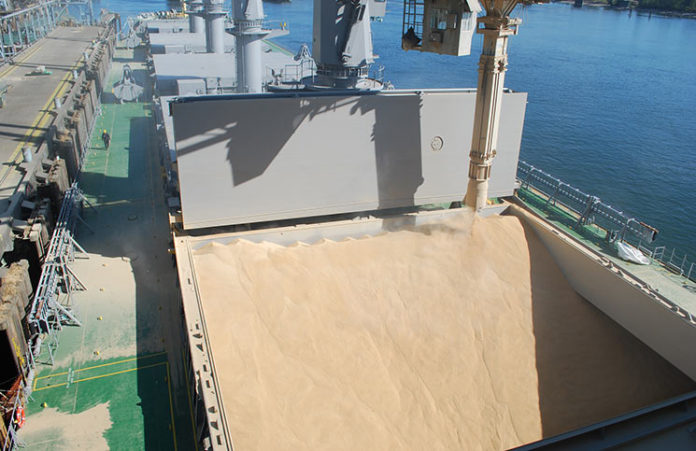
The Trump Administration’s trade war with China continues to rage in 2019, but so far the Port of Vancouver USA has been able to keep pace with the changes.
The president raised taxes on several Chinese goods this spring from 10% to 25% in an effort to cut down on China’s theft of American companies’ intellectual property and China’s dumping of products in certain industries like steel in order to drop the global price. China’s earlier retaliatory tariffs against the U.S. began in 2018 and include a 25% tax on soybeans, and China could introduce more tariffs this year as the trade war continues.
The process has hurt American soy farmers over the past year, leading the administration to launch a $16 billion trade aid package. But the Port of Vancouver – which ships about 5 million metric tons of grain each year, including soy – has been able to shift its shipping patterns to keep commerce flowing.
“Last year no doubt our soybean numbers went down,” said Alex Strogen, chief commercial officer at the Port, noting that prior to 2018, the port shipped a bit less than 2 million metric tons of soybeans each year. “Last year we shipped just 246,000 tons of soybeans to China. But here in Vancouver we’ve been nimble enough to shift gears. This year we backfilled those soybeans with corn, and we can do that with other commodities going forward.”
The corn has gone to other countries besides China, but the process filled the gap from reduced soybean demand and has kept business flowing. Oddly enough, in 2019 China has returned to buying a small amount of soybeans despite the high tariffs, Strogen added.
“Why are they buying them now? That I can’t answer,” Strogen said, speculating that the country may be trying to show the Trump Administration good faith, or that it may just not be able to get enough from countries like Brazil.
So far, in 2019, the Port has shipped 558,000 metric tons of soybeans to China, he said.
Another area of the trade war that hasn’t been as widely discussed is the copper concentrate market, which is a commodity China needs but has been buying less of after tariffs.
Copper concentrate contains about 25% pure copper and is used in a host of countries in computer and electronics markets. The copper concentrate that moves through the Port mostly comes from Montana.
“It’s basically copper ore that’s been crushed and concentrated to be smelted for use elsewhere,” said Zack Merrill, the Port’s sales account manager.
In 2017, 100% of the copper concentrate that shipped through the Port of Vancouver went to China. In 2018 that dropped to 55%, or about 300,000 metric tons. And in 2019 so far it’s zero.
“A lot of that copper goes to the far East, and it gets into batteries, battery-powered electric vehicles and that sort of thing,” Strogen said. “This is a market we see as a growing sector for the Port. China also needs that product for manufacturing and building electric cars, but we’ve been able to find other markets to work with.”
Despite China’s dropping demand for copper concentrate, the Port has been able to find buyers in Japan, Bulgaria and elsewhere. The shipping amounts through the facility have actually grown by about 40% since 2017 – they’re just no longer shipping copper concentrate to China.
“The trade pattern has shifted from China, but a lot of products are simply going to other places,” Strogen said.
As for concerns about steel imports being hurt by the trade war back in 2018, the Port has been able to shift and is buying steel from Russia and Mexico instead.
“The things we import here are pretty much raw materials,” Merrill said. “Steel, chemicals, fertilizer. And a lot of those things don’t come from China anyway.”
Trump’s trade talks with Japan have been postponed until early fall. And while meetings this May seemed to go well between Trump and Japanese Prime Minister Shinzo Abe, tariff issues with that country could create a new round of headaches for the Port, Strogen said.
“This is a pretty challenging time to be involved in international trade,” Strogen said. “The Port is exceptionally diversified and the places we trade with help us ride out the highs and lows of global trade. We have successfully been able to keep that diversification going, ride it out and continue to perform above expectations.”



